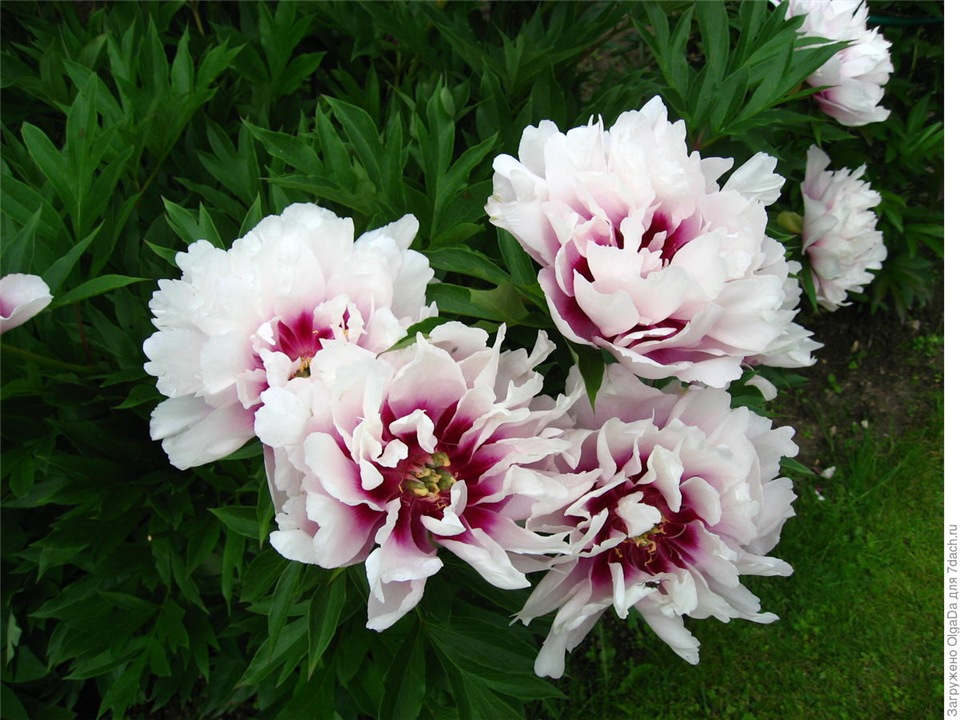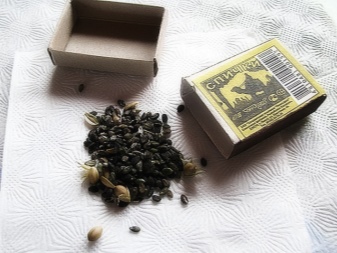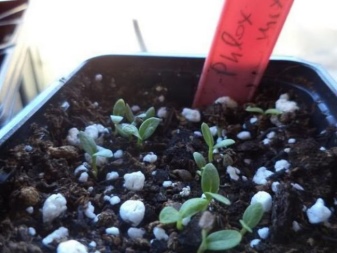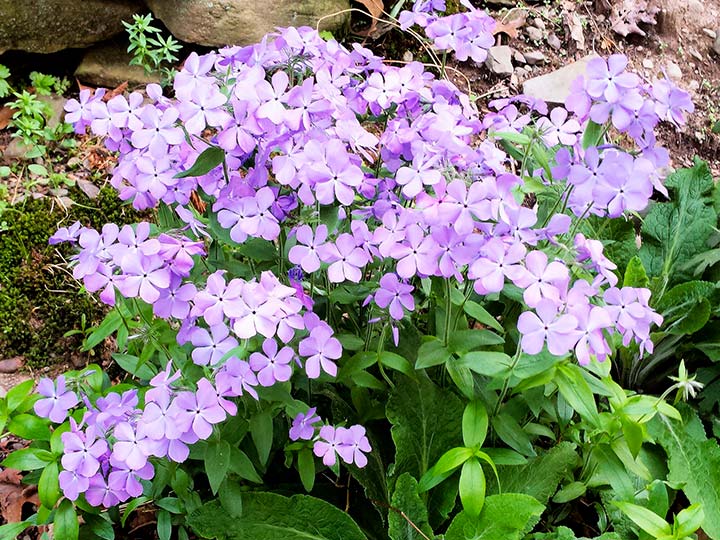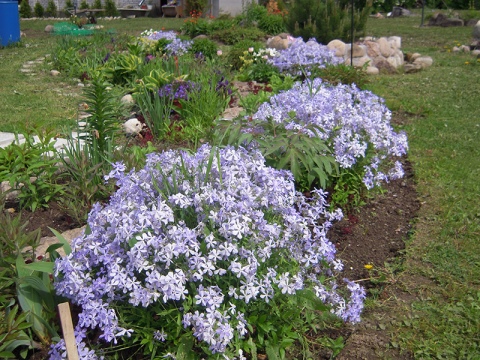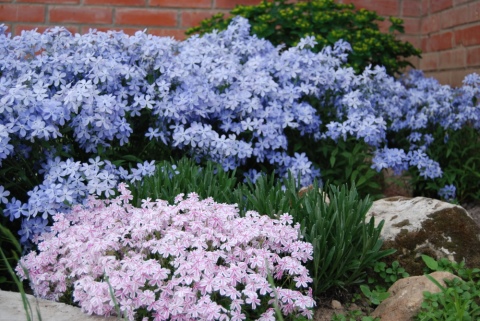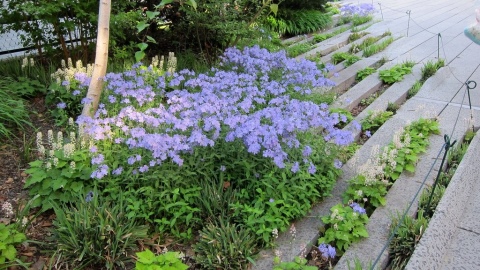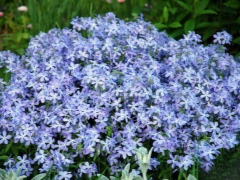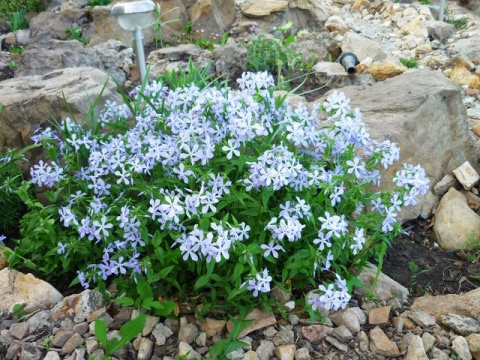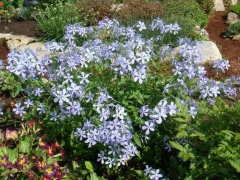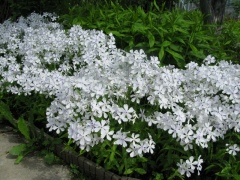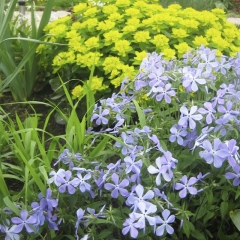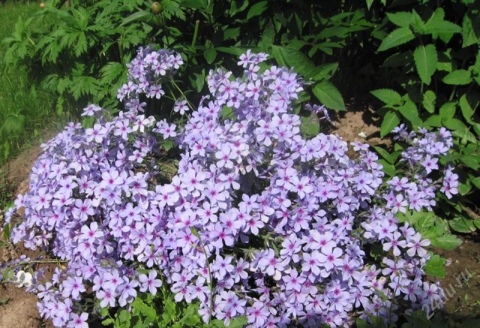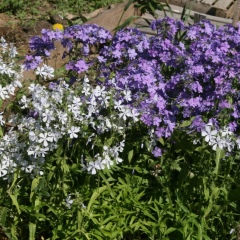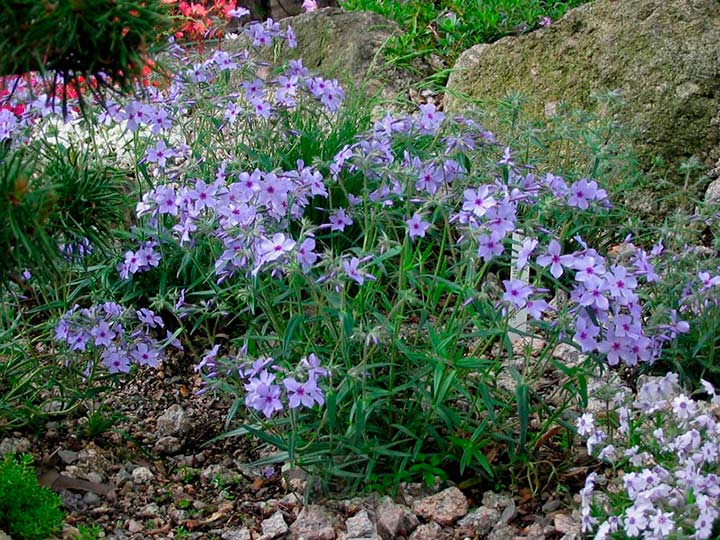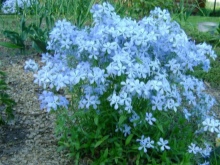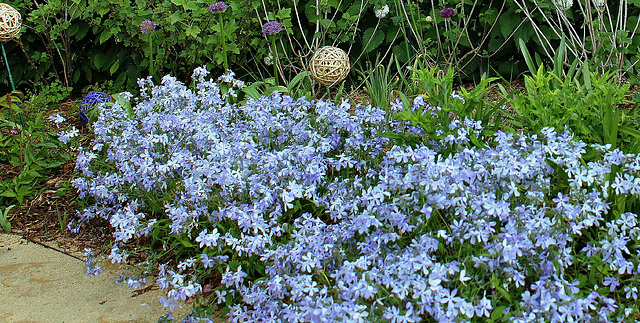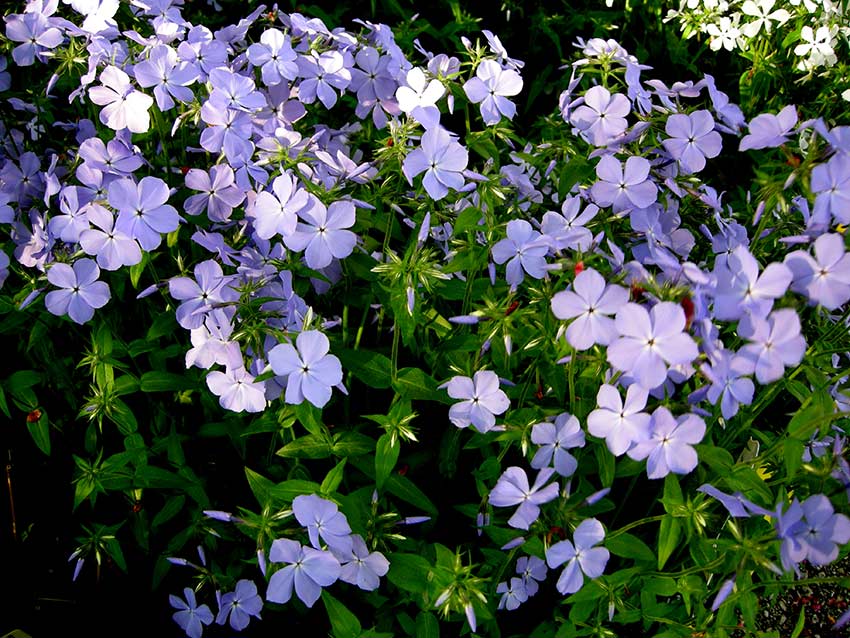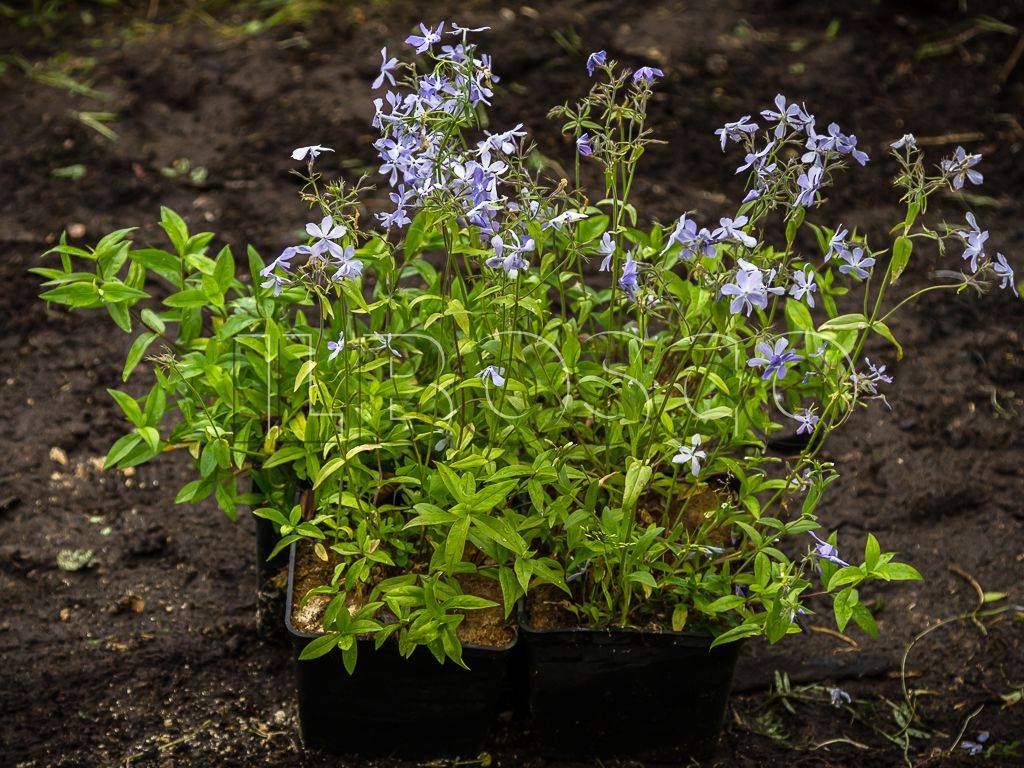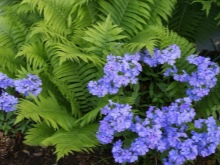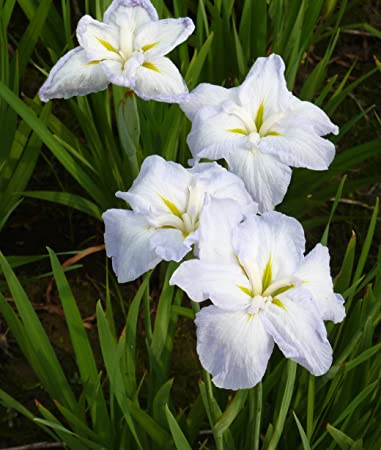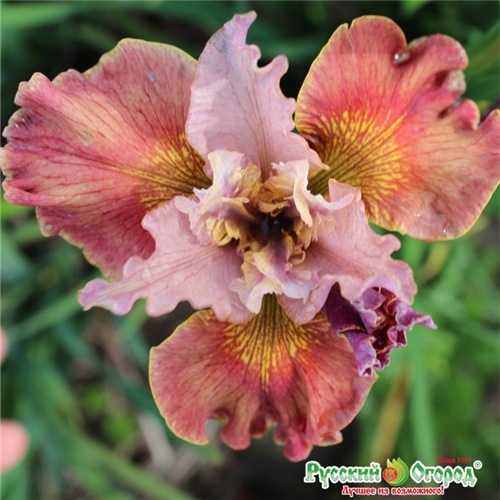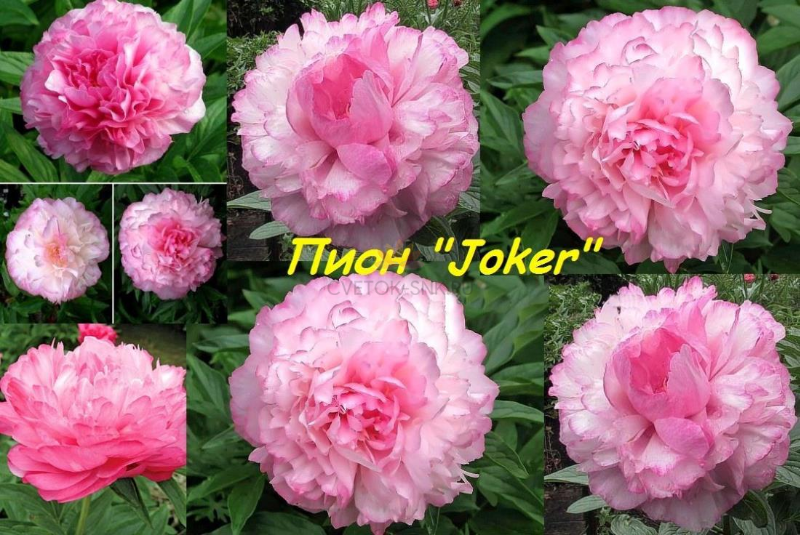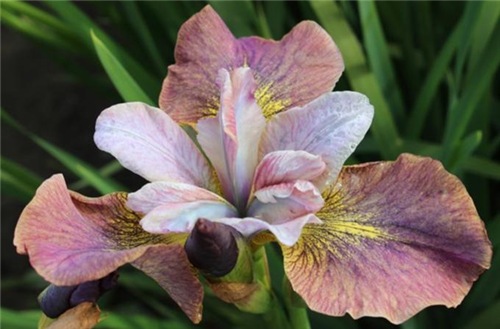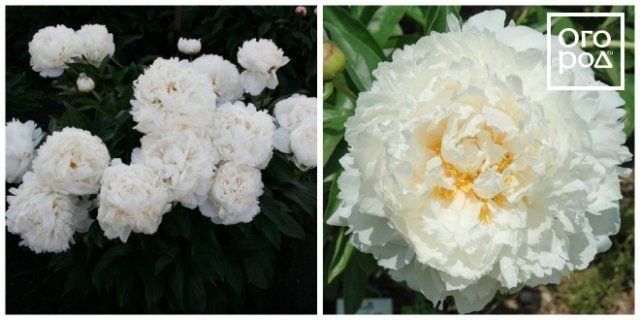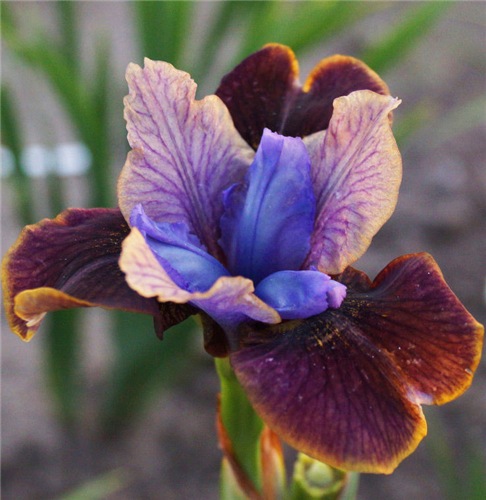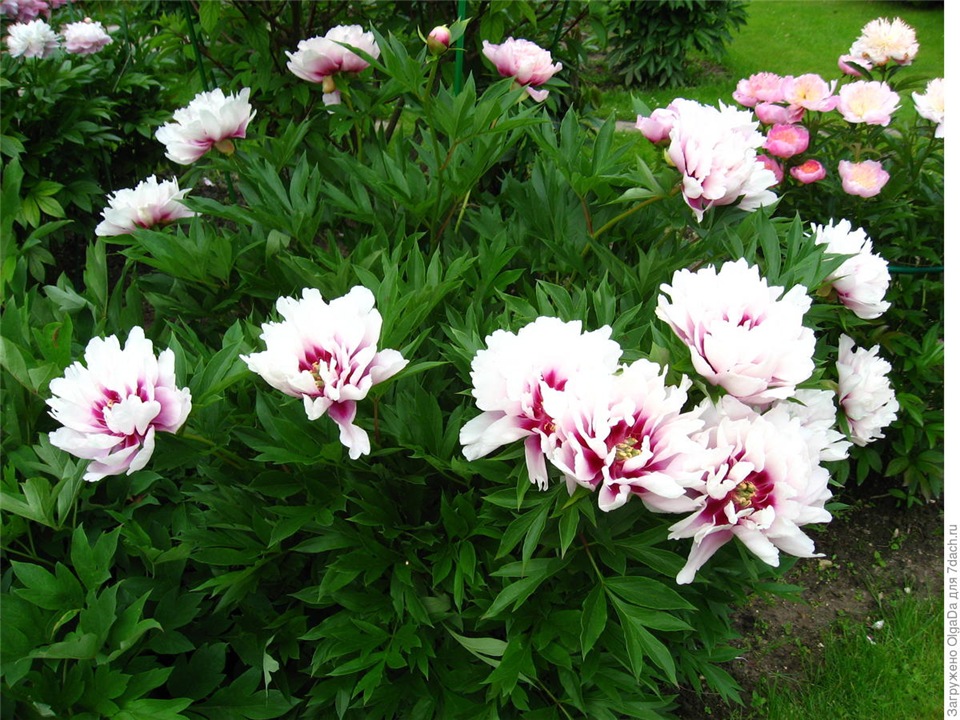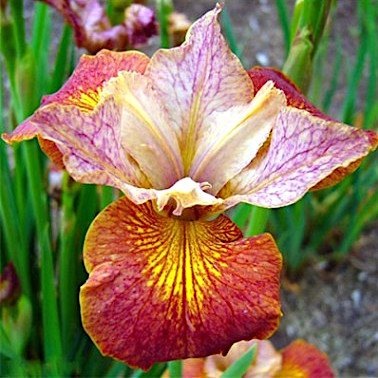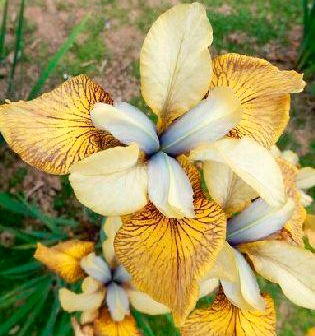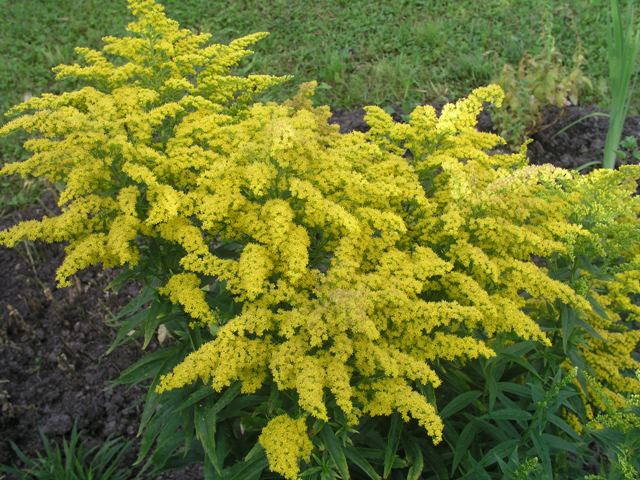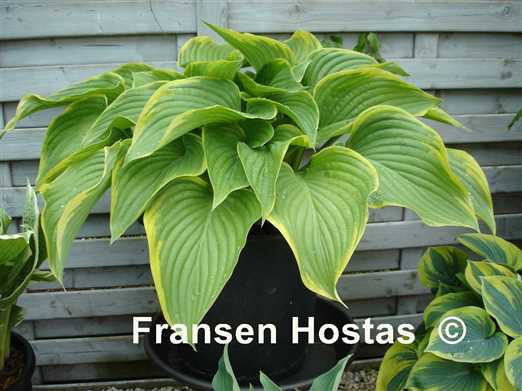New early varieties of phlox
Due to the fact that most of the annual and perennial phloxes begin to bloom at the end of June, flower growers give special preference to early varieties. They are capable of blooming in good weather conditions by the end of May. We have selected for you a line of new early phlox, varieties with photos and names of which are presented below. The entire assortment is of medium flowering duration.
"Fog"
Differs in wheel-shaped inflorescences, consisting of medium flowers up to 3.5 cm in circumference. "Fog" easily changes its color with the onset of evening twilight and in cloudy weather. At this time, it acquires a bluish tint, the rest of the time it is pale lilac with a pink ring in the center. Delicate petals are distinguished by their volumetric shape.
The bush reaches medium size, but in good conditions it grows up to 80 cm, suitable for planting under a hedge. It tends to grow well. Stems are strong, well leafy. "Fog" perfectly reproduces by cuttings and dividing the bush.
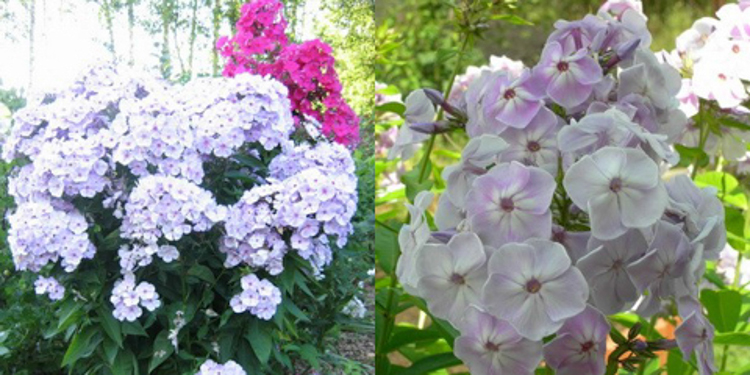
Phlox varieties Tuman
"Yunnat"
Large flowers of a bright warm crimson color with a red center tolerate the sun well without fading on it. Inflorescences of medium density have a conical shape. Long-term flowering ends with ripening of seeds for 40-50 days. Does not require frequent replanting and separation. The bush is not sprawling, compact. With good watering and fertilization, it reaches a height of 80 cm. In autumn, as a preventive measure, antifungal procedures are required.
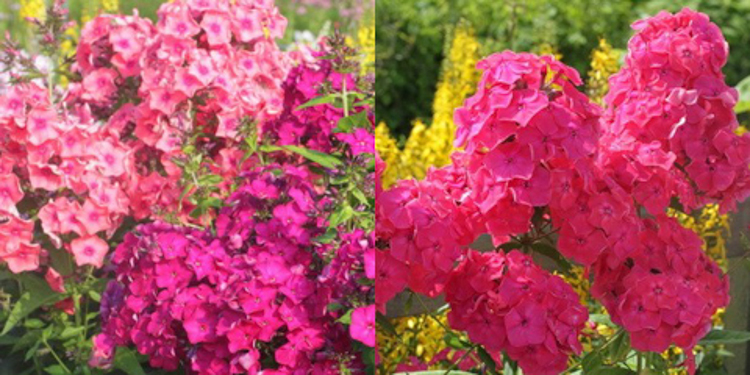
Phlox varieties Junnat
"Sleeping Beauty"
White flowers, as a rule, have very delicate petals, quickly fade under the sun's rays. "Sleeping Beauty", so named because of the white buds with a lilac center, is susceptible to disease, poorly tolerates changes in temperature and humidity. It is advisable to treat the plant with a fungicide at the first manifestations of fungal diseases.
The inflorescence has a flat round shape, loosely filled with medium-sized flowers up to 3.5 cm in circumference. Stems reach a height of 60 cm. The variety looks good in a flower bed in combination with other plants. Not recommended to be planted next to red species to avoid discoloration.

Phlox varieties Sleeping Beauty
"Taras Shevchenko"
The species, named after the Ukrainian poet, is distinguished by its bright appearance and resistance to weather changes. The bush is large, strong, grows up to 80 cm. It is recommended to plant it along the fence. Inflorescences are very dense, large, rounded, composed of coral flowers with pink and orange veins.

Phlox varieties Taras Shevchenko
"Apple Blossom"
A new species that has already gained popularity thanks to the marvelous color of the petals. "The color of the apple tree" has absorbed the play of white and light pink shades. Early large flowers delight not only with large umbrella hats, but also with a wonderful aroma.
The bush grows not large, up to 50 cm tall. Outwardly compact, well-formed. Easily transfers transplants and bush division. Not susceptible to disease, winter hardy.
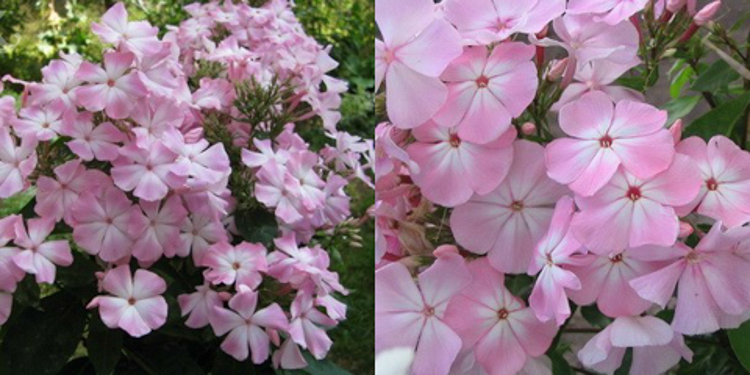
Phlox varieties Apple Blossom
What plants are suitable for propagation?
The first step is to notice in some way during flowering each variety. You can stick self-adhesive price tags on the stem, which are sold in rollers, by writing on each variety number (and indicating in a separate notebook which variety goes under which number). Some gardeners knit ribbons or threads of different colors on the stems.
It's good if at the time of planting store seeds you pay attention to the packaging information. Plants marked F1 are not suitable for future seed collection, as they are hybrids
They will never grow flowers similar to the variety from which you collected them. But as an experiment, you can plant the seeds collected from the hybrids somewhere in an inconspicuous place on the site. It happens that flowers grow with an extraordinary color or shape of petals that do not retain the characteristics of the variety, but in themselves are quite spectacular.
Plant the bags without F1 marking separately so that you can collect seeds from these plants later. When blooming, sweep the most lush and well-blooming phlox. They will make good seed material.
Features of planting varieties
In order for the Blue Paradise phlox seedling to take root and delight with its beauty for a long time (it grows in one place for 4-5 years), you need to pay special attention to planting
Finding a place for phlox
Phlox Blue Paradise loves moist, loose, fertile soil and light partial shade in a cool, draft-free place. Therefore, it is better to plant it near trees or shrubs, but so that the diffused sunlight hits the plant in sufficient quantities. In a too shady area, the inflorescences become pale and loose or stop blooming altogether.
Note! You cannot plant phlox near birch, spruce or lilacs, their root system is so powerful that it can drown out the roots of flowers. It is better to make the flower bed high with a slope to prevent stagnation of water, which the plant cannot tolerate.
Soil preparation
The flower loves loamy, sandy loam and black earth soil. The place for planting phlox Blue Paradise is prepared in the fall, and for autumn planting, three weeks before disembarkation. In September, they dig up the earth, remove debris and weeds, add humus or compost to the bayonet of a shovel. If the soil is heavy, sand is added to the humus, and if it is acidic, lime (200 g per 1 m²). It is also recommended to immediately lay mineral fertilizers and wood ash.
Planting phlox
A plant is planted in a prepared hole 25-30 cm deep to a depth of 3-5 cm from the root collar to the surface of the earth. The distance between the plants is from 40 to 60 cm. When growing from seeds, sowing begins in the second half of March, after two weeks the first shoots appear, and after three weeks you can proceed to picking.
Watering
When the soil dries up, the leaves of the plant lose their decorative effect, dry out and crumble, the flowering time is reduced. It is necessary to ensure that the soil always remains slightly moist, but without stagnant water. It is necessary to water at the root, without falling on the leaves and inflorescences in the evening.
Important! After watering, it is required to loosen the soil, which again will prevent stagnant water and saturate the roots with oxygen
Top dressing
For healthy growth and long flowering, it is enough to feed the plant just twice:
- in spring, during plant growth, nitrogen fertilizers are applied for more intensive development;
- in the middle of summer, complex mineral fertilizers are needed (phosphorus will give the plant health, and potassium will enhance flowering) and a solution of urea at the root.
Note! Phlox paniculate Blue Paradise is very fond of processing with an ash solution (for 2 liters of water 300 g of wood ash), with which the plant is watered at the root. Fresh manure for a plant is strictly contraindicated, it can lead to the formation of rot and death of the bush
Pruning
Phlox is cut off after flowering to a height of about 10 cm from the ground. Spring pruning is also practiced. Shoots are left for the winter to retain the snow mass. The cut stems are burned, and the bush is treated with fungicides.
Pruning phlox for the winter
Preparing phlox for winter
Phlox Blue Paradise is frost-resistant and does not require much effort in preparation for winter. To increase frost resistance, it is recommended to apply potash fertilizers at the end of August. The cut off bushes are sprinkled with earth a little or sprinkled with humus. Then they are covered with branches or spruce branches to trap snow. If the snow cover is light, you should throw snow on the flower bed to better protect the plant.
Phlox paniculata impressive (Phlox paniculata Feelings).
There are varieties that do not have flowers in our usual sense. This is phlox paniculata eagle owl or paniculate eagle owl (Paniculata Feelings). You can translate this name as phlox paniculata impressive, sometimes they are called terry phlox, but most often eagle owls. The Dutchman Rene Van Gaalen is considered the originator of the owls.
Long before the appearance of foreign varieties, the first eagle owl named Devil was shown at our phlox exhibition in 1993. The author of this unusual greenish-brown phlox is Mikhail Nikolaevich Krutov, a member of the Moscow Flower Club, a well-known breeder and florist. But, as you know, there is no prophet in his homeland, and this phlox was not appreciated at its true worth. And now we are buying Dutch varieties.
In appearance, owls can be divided into two groups. In some, the inflorescences are formed by colored needle-like bracts (Empty Feelings, Midnight Feelings, Pleasant Feelings), in others - pink-like buds of modified petals (Fancy Feelings, Natural Feelings, Red Feelings, Pure Feelings). The characteristic main feature of eagle owls is large inflorescences and a long flowering period (up to 10-12 weeks). Empty Owls (Empty Feelings) have a golden brown inflorescence, Midnight Feelings have dark brown, Pleasant Feelings have light green. The needle-like bracts are so small that the inflorescences appear fluffy. Fancy Feelings' bright pink sterile flowers have narrow, elongated petals. The inflorescence is very dense. The color and structure of the inflorescence of Natural Feelings are peculiar - white-pink-green slightly twisted "petals" look like half-open buds, which are collected in large dense brushes, so the top of the phlox resembles a plume. The red flowers of Red Feelings also consist of modified narrow petals.
Both variegated phlox and eagle owl bloom in July, like ordinary paniculate phlox.
Popular varieties with photos
Perennial phloxes differ not only in color and shape of buds, but also in height, flowering time. There are so many options that each owner of a garden or summer cottage can choose a variety to his liking - for a flower bed or an alpine slide.
Experts have divided the varieties into three groups. The first includes the so-called subulate phlox - undersized and creeping. The height of the plants that make up the “spread out” group reaches 40 cm. Phloxes from the “paniculate” group are bushy, lush, their average height is 1.2 m, and the maximum is 1.8 m.
Mayshnee
The shoots of this variety are creeping, not erect
This is a typical representative of subulate phlox, plant height is 10-15 cm. There are so many white flowers that they resemble snowdrifts. Phlox Mayshnee bloom twice a season: in May - June and August - September.
Amethyst
Amethyst has large flowers with a rich aroma
The plant is of medium height (80–90 cm), distinguished by large bluish-purple inflorescences. Flowering occurs in July - August.
Tiara
Tiara is a beautiful variety with corrugated swirling petals
Phloxes of this variety bloom all summer. The stem length reaches 60 cm, and the flowers are unusually spectacular - double, 3.5 cm in diameter, white, with a slight green tint.
Chattahoochee
Chattahoochee is a compact variety that prefers sunny locations
Experts recommend this unpretentious variety for growing in rocky gardens and rock gardens. The height of the stems is up to 25 cm, the inflorescences are pale lilac.
Alyonushka
Alyonushka does not grow as fast as most other varieties of phlox
Phloxes of this variety are distinguished by beautiful pink inflorescences, however, you can enjoy the beauty for only one month, starting from mid-June. Alyonushka's stem reaches a length of 0.5 m.
Bonita
Phlox Bonita will be able to quickly cover the soil with an elegant carpet of lavender shades
Bonita's flowers, like Alyonushka's, are pink, but brighter. Flowering occurs in July - August, regardless of temperature anomalies.Height - from 45 to 60 cm. The plant has a high winter hardiness.
Blue Paradise
This variety has strong stems, so rain is not terrible for it.
This is the ancestor of most varieties popular with flower growers, the classic paniculate phlox, the height of which can reach 1.5 m, and flowering lasts from July to September. He is sometimes called "chameleon" for his unusual play of various shades of blue and blue.
Smoky coral
The flowers of this phlox fade a little towards the end of the season.
Belongs to the tall group (stem length is 70–80 cm). It is valued for the rare color of inflorescences - rich pink with a light ash bloom.
The best breeding method
The easiest way to reproduce phlox, which gives 100% result, is to divide the mother bush into several parts. It should be noted that the procedure is not only desirable but also necessary for specimens that grow well.
Advice. Bushes that very quickly capture free space near them, become lush, and become smaller over time, most likely refer to rapidly growing. They should be divided at least every three years. The rest of the plants are planted every six or even seven years.
To divide the bush, you need to carry out just a few activities:
- dig it in a circle to the depth of the roots (about one bayonet of a shovel), pull gently by the shoots and pull out;
- determine how many parts you need to divide it, and then, using a sterile knife or a sharp shovel, cut it into several bushes with three to five shoots;
- the place of the cut can be sprinkled with charcoal;
- the holes for planting must be prepared in advance, add humus or mineral dressings, ash, lime to them (only if the soil is acidic);
- mix all additives and let stand for at least a week;
- before planting, the recess is well watered, a young plant is planted and the growth point is covered by 5 cm from above, so that new buds form;
- after that, it will not be superfluous to have another layer of humus and compost;
- in the fall, seedlings are sprinkled with mulch by another 10 cm - this way the plants will root better before the onset of frost.
Splitting a phlox bush
On a note. Some varieties of phlox can grow in one flower bed for up to 15 years, but they also age. Only lateral shoots are renewed, and the central stem dies off. Regular replanting helps to renew the plant, prolonging its beauty for years to come.
In conclusion, we invite you to familiarize yourself with the magnificent collection of phloxes of one of the amateur gardeners.
Also presented with recommendations for their cultivation. l>
Description of the species
Phlox Spread (or Spread) is a herbaceous perennial plant that belongs to the Phlox genus and the Sinyukhov family.
This species has creeping-type stems with a turf formed on them. It reaches a height of 20-30 cm. Its leaves are lacteate, juicy-green. The inflorescences form a splayed shield, the petals are in the form of droplets, attached to the core with a narrow part. It is because of this structure of the inflorescences that these phloxes are called "spread". The flowers themselves are about 3 cm in diameter.

Flowers of this species have a pale blue color.
The flowering period lasts a little longer than a month, from the end of May. Its splendor can vary from year to year, but with proper care, the garden flower will bloom equally brightly every time.
Historical fact! The phlox was officially described and introduced into the culture in the 18th century, but even before that it was known to botanists.
In nature, this plant originally grew in North America, in areas with rocky, dry soil, as well as in moist forests. Now this plant can be found even in the garden plots of central Russia or in Siberia.
Care Tips
These flowers do not require special care.
The set of actions is practically no different from caring for other garden flowers, but it is important to observe some of the nuances
Watering and weeding plants
Phloxes love moist soil. If the planting site is in the shade, and there is a pond or automatic sprayers nearby, you do not need to water the plant.
In hot weather, especially if the flower bed is in a sunny area, you need to water the plant a little every day. Water stagnation should not form. Watering is best done with settled cold water, in the evening hours.
Since the soil around phlox is usually rather loose, weeds often appear in it. They must be removed periodically so that nutrients and moisture are not taken from the flower.
Top dressing
Competent feeding will help to increase the splendor of flowering and extend its period. In the case of phlox, you can alternate mineral and organic fertilizers.
Fertilizers are applied in late spring and early June. For these purposes, the following are suitable:
- chicken droppings and superphosphate;
- a mixture of fluorine and potassium salt;
- chicken droppings and potassium salt.
Each product is diluted with water, then the plant is watered.
Important! There is no need to fertilize phlox after the flowering period.
Pruning
Pruning is necessary for phlox after the flowering period. Firstly, wilted shoots will spoil the decorativeness of the flower garden, and secondly, it is easier to prepare the flowers for wintering and the next flowering.
You need to cut it so that about 10 cm above the ground remains from the shoots. The base of the bush is then sprayed with a fungicide.
Preparing phlox for winter
Before the period of cold weather under phlox, the land must be mulched. For this, horse manure, peat and humus are suitable. Half a bucket of manure or 3/4 buckets of peat will go under one bush.
From above, the trimmed bushes are closed with spruce branches or tops from various plants. In addition, it is not necessary to cover phlox with burlap or in other ways, they calmly endure frosts. In the spring, after the cold weather disappears, the spruce branches are removed.

Phlox pruning process
Reproduction of ground cover phlox
All methods of vegetative propagation are suitable for the resettlement of this perennial: seeds, cuttings, rhizomes. On sale are seedlings in containers that can be planted at any time from May to September. The seeds have a short germination period (1-2 years) and are represented by varieties and hybrids (F1).
Important! If you need a plant that does not grow too quickly, then buy varietal seeds, and hybrids are distinguished by a richer palette of shades and a high growth rate
Growing phlox from seeds
Seeds are most often sown in open ground in a well-lit place in the second decade of April, when the soil thaws. They emerge very amicably and do not need special care. Seedlings of ground cover phlox are sown only when they are collected later to be planted in containers, rock gardens, flowerpots.
Loose rocky soil is required. Clay, heavy with a lot of humus - not good. It is optimal to dig a planting trench 35 cm deep, filling its bottom with a layer of about 10 cm from a mixture of crushed stone and sand. Next, a mixture of wood ash, fertile soil, sand and crushed stone of the finest fraction is poured into the trench in a ratio of 1: 4: 1: 1.
Sowing is carried out practically without deepening. Experienced gardeners recommend spreading the seeds as you want to see phlox bushes in the future, and then sprinkle them on top with a layer of the finest mulch made from sawdust, needles, and chopped grass. Strong seedlings will easily overcome this barrier and will not fade if they cannot be watered in time.
Important! For the whole summer, three additional dressings with any complex mineral fertilizer for flowering ground cover plants are quite enough.In spring and autumn, you can add mullein, which is bred in a ratio of 1:10
Watering is necessary regularly, but stagnation of water should not be allowed. To do this, there must be a lot of loosening components in the soil. The roots of the flower easily rot when waterlogged. A place for planting is always chosen so that in the spring, when the snow melts, puddles do not form on it.
Reproduction of phlox by green cuttings
A twig with several pairs of leaves is an excellent planting material. At almost any time of summer, you can freely cut the cuttings and use them for propagation. In the selected area, they are added dropwise at an angle, and then watered regularly. Rooting usually takes place in 2 weeks.
Cuttings can also be rooted in water. To do this, cut off green twigs and put them in cups, immersing them in water by 2-3 cm. On average, the roots grow in 2-3 weeks, but you need to carefully monitor that the water is renewed in containers every day to clean. Planting can be carried out immediately to a new location.

